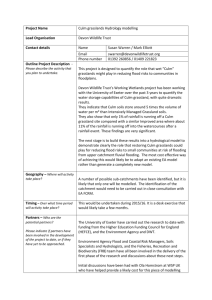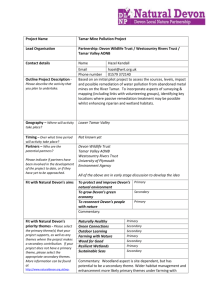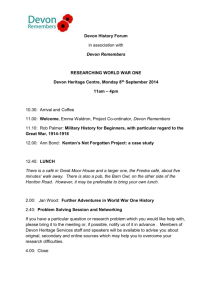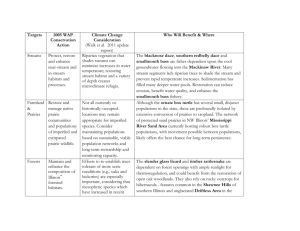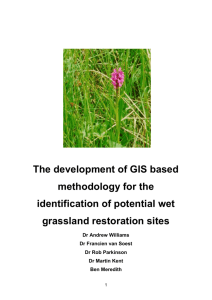Working Wetlands – DWT - Local Nature Partnership
advertisement
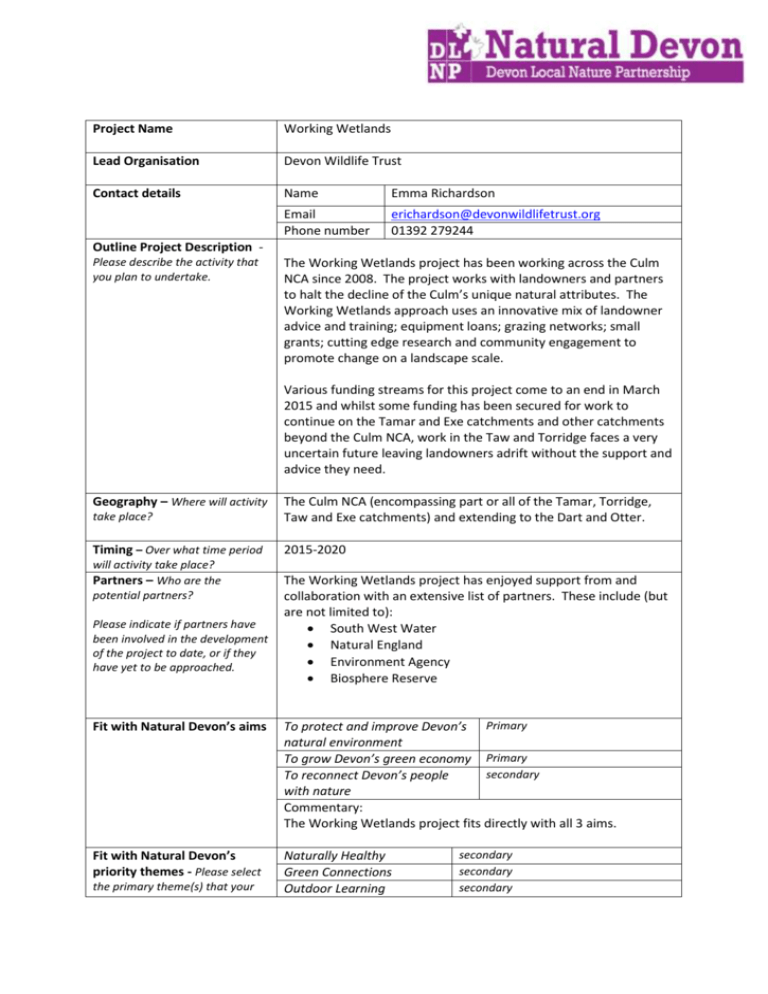
Project Name Working Wetlands Lead Organisation Devon Wildlife Trust Contact details Name Emma Richardson Email Phone number erichardson@devonwildlifetrust.org 01392 279244 Outline Project Description Please describe the activity that you plan to undertake. The Working Wetlands project has been working across the Culm NCA since 2008. The project works with landowners and partners to halt the decline of the Culm’s unique natural attributes. The Working Wetlands approach uses an innovative mix of landowner advice and training; equipment loans; grazing networks; small grants; cutting edge research and community engagement to promote change on a landscape scale. Various funding streams for this project come to an end in March 2015 and whilst some funding has been secured for work to continue on the Tamar and Exe catchments and other catchments beyond the Culm NCA, work in the Taw and Torridge faces a very uncertain future leaving landowners adrift without the support and advice they need. Geography – Where will activity take place? The Culm NCA (encompassing part or all of the Tamar, Torridge, Taw and Exe catchments) and extending to the Dart and Otter. Timing – Over what time period 2015-2020 will activity take place? Partners – Who are the potential partners? Please indicate if partners have been involved in the development of the project to date, or if they have yet to be approached. The Working Wetlands project has enjoyed support from and collaboration with an extensive list of partners. These include (but are not limited to): South West Water Natural England Environment Agency Biosphere Reserve Fit with Natural Devon’s aims To protect and improve Devon’s Primary natural environment To grow Devon’s green economy Primary secondary To reconnect Devon’s people with nature Commentary: The Working Wetlands project fits directly with all 3 aims. Fit with Natural Devon’s priority themes - Please select Naturally Healthy Green Connections Outdoor Learning the primary theme(s) that your secondary secondary secondary project supports, as well as any themes where the project makes a secondary contribution. If your project does not have a primary theme, please select the appropriate secondary themes. More information can be found at Farming with Nature Wood for Good Resilient Wetlands Sustainable Seas http://www.naturaldevon.org.uk/wpcontent/uploads/2014/01/Final-DLNPprospectus-jan20141.pdf This project directly delivers against the LNP’s Resilient Wetlands and Farming with Nature themes, covering a large portion of Devon. In particular the new phase of the Working Wetlands Project will cover: Tamar, Dart, Exe, Fernworthy, Otter, Barnstaple Yeo as well as continuing to work in the Taw and the Torridge if funding can be secured. Fit with HOTSW LEP Strategic Economic Plan Priorities. Please describe how your project contributes to the Heart of the SW LEP’s Priorities for Growth (see Appendix A). Please list the priorities where your project could make a direct contribution and explain how it will contribute. Appendix 1 provides a summary of the Priorities for Growth. More information can be found: http://www.heartofswlep.co.uk/strategiceconomic-plan Primary secondary Primary no alignment Commentary: This project can deliver against the HOTSW LEP Priorities for: Improving infrastructure for growth by delivering sustainable solutions for flood management through natural engineering projects. Supporting higher value growth by developing innovative techniques for habitat creation. Creating a favourable business environment by improving access to RDPE funding for farmers and stimulating enterprise in the agricultural environment. Creating a responsive environment by developing agricultural and rural skills, providing opportunities for training and skills development and improving technical land management skills within the agricultural industry. Financials Outcomes - Please describe what you expect the project to achieve in terms of What is the estimated total project cost? What proportion of total project cost are capital costs? Have you secured any funding for the project yet? If so, list amounts and sources. In your view, what are the potential sources of funding for this project? Environmental Outcomes: £4,000,000 25% £2,650,000 secured from South West Water European funding, landfill tax, UK government B2020 funding The project will have made a significant contribution Environmental, Social and Economic Outcomes towards the delivery of Biodiversity 2020 targets The Working Wetlands catchments are more robust and resilient landscapes, due to strategic targeting of seminatural habitat creation and management The delivery of WFD and FCRM objectives in priority areas of the catchments are supported by targeting of seminatural habitat creation and management Landowners are targeted and supported to ensure opportunities for habitat enhancement and resource protection and management are optimised The status and extent of priority species is enhanced Flood mitigation and water quality is enhanced in priority areas of the catchment targeting semi-natural habitat creation and management Social Outcomes: The health and wellbeing of local people and the local workforce is supported by connection and interaction with the local landscape Traditional farming families are supported to continue farming on their family holdings. Economic Outcomes: Quantifiable outputs - Please provide any information you have about quantifiable benefits? Please describe how these have been estimated. Consultation – What consultation has already occurred is more required? Statutory Approvals – What statutory approvals will be required for the project? Are these in place? Risks – What are the main risks associated with this project? Landowners have the necessary skills, knowledge and resources to deliver and manage resilient, sustainable farming systems. Research projects provide new and additional benefits of the value of the natural environment in supporting the local economy 280 farms will have revised management agreements to deliver environmental outcomes 1,000 acres of Culm grassland restored or re-created Further targets to be delivered if funding is secured for Torridge and Taw The Working Wetlands project works closely with a number of partners through the Project Advisory Group and the Culm Advisors Group. The project is also linked into the Tamar, North Devon and East Devon Catchment Partnerships. Ongoing consultation with Natural England, SWW and EA will be required during the project. Case by case approvals for certain habitat, in-stream or other siterelated works. Lack of landowner engagement due to reduction in agrienvironment funding availability. People Business Place Appendix 1: Heart of the SW LEP Priorities for Growth Creating the Conditions for Growth Improving our infrastructure and services to underpin growth Maximising Productivity and Employment Opportunities - stimulating jobs and growth across the whole economy Capitalising on our Distinctive Assets Utilising our distinctive assets to create opportunities for business growth and better jobs The infrastructure and facilities needed to support higher value growth: Specialist marine sites Science/Innovation infrastructure Maximising our environmental assets Infrastructure for growth: Transport and accessibility Digital infrastructure Sustainable solutions for flood management Energy Infrastructure The infrastructure and facilities to create more and better employment: Enterprise infrastructure Strategic employment sites Unlocking housing growth Creating a favourable business environment A simpler, more accessible, business support system, tailored to our needs o Improving access to finance o Stimulating enterprise and growth Creating a responsive environment, where businesses and individuals can reach their potential: Skills infrastructure and facilities Accessibility to education/employment (transport, careers advice and digital inclusion) Employer engagement and ownership Achieving more sustainable and broadly based business growth: Reaching new markets (on-line, supply chains, public sector) Globalisation (exports and inward investment) Supporting higher value growth: Innovation through Smart Specialisation Building our capacity for innovation Increasing employment, progression and workforce skills. Moving people into employment Supporting people to progress to better jobs Improving workforce skills Creating a world class workforce to support higher value growth: Enterprise and business skills Technical and higher level skills development and retention Maximising the skills and employment opportunities aligned to our transformational opportunities.
